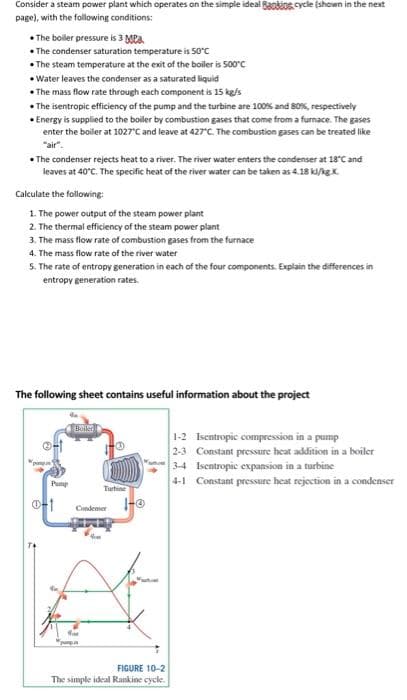Consider a steam power plant which operates on the simple ideal Bapkos.cycle (shown in the next page), with the following conditions: • The boiler pressure is 3 MEa • The condenser saturation temperature is 50°C • The steam temperature at the exit of the boiler is 500°C • Water leaves the condenser as a saturated liquid • The mass flow rate through each component is 15 kg/s • The isentropic efficiency of the pump and the turbine are 100s and 80%, respectively • Energy is supplied to the boiler by combustion gases that come from a furnace. The gases enter the boiler at 1027'C and leave at 427C. The combustion gases can be treated like "air". • The condenser rejects heat to a river. The river water enters the condenser at 18°C and leaves at 40°C. The specific heat of the river water can be taken as 4.18 kigK
Consider a steam power plant which operates on the simple ideal Bapkos.cycle (shown in the next page), with the following conditions: • The boiler pressure is 3 MEa • The condenser saturation temperature is 50°C • The steam temperature at the exit of the boiler is 500°C • Water leaves the condenser as a saturated liquid • The mass flow rate through each component is 15 kg/s • The isentropic efficiency of the pump and the turbine are 100s and 80%, respectively • Energy is supplied to the boiler by combustion gases that come from a furnace. The gases enter the boiler at 1027'C and leave at 427C. The combustion gases can be treated like "air". • The condenser rejects heat to a river. The river water enters the condenser at 18°C and leaves at 40°C. The specific heat of the river water can be taken as 4.18 kigK
Elements Of Electromagnetics
7th Edition
ISBN:9780190698614
Author:Sadiku, Matthew N. O.
Publisher:Sadiku, Matthew N. O.
ChapterMA: Math Assessment
Section: Chapter Questions
Problem 1.1MA
Related questions
Question

Transcribed Image Text:Consider a steam power plant which operates on the simple ideal Baokios cycle (shown in the next
page), with the following conditions:
• The boiler pressure is 3 MPa
• The condenser saturation temperature is 50°C
• The steam temperature at the exit of the boiler is 500°C
• Water leaves the condenser as a saturated liquid
• The mass flow rate through each component is 15 kg/s
• The isentropic efficiency of the pump and the turbine are 100s and 80%, respectively
• Energy is supplied to the boiler by combustion gases that come from a furnace. The gases
enter the boiler at 1027'C and leave at 427C. The combustion gases can be treated like
"air".
• The condenser rejects heat to a river. The river water enters the condenser at 18"Cc and
leaves at 40°C. The specific heat of the river water can be taken as 4.18 k/gK.
Calculate the following:
1. The power output of the steam power plant
2. The thermal efficiency of the steam power plant
3. The mass flow rate of combustion gases from the furnace
4. The mass flow rate of the river water
5. The rate of entropy generation in each of the four components. Explain the differences in
entropy generation rates.
The following sheet contains useful information about the project
Baiet
1-2 Isentropic compression in a pump
2-3 Constant pressure heat addition in a boiler
3-4 Isentropic expansion in a turbine
4-1 Constant pressure heat rejection in a condenser
Pump
Turhine
o-1
Condemer
FIGURE 10-2
The simple ideal Rankine cycle.
Expert Solution
This question has been solved!
Explore an expertly crafted, step-by-step solution for a thorough understanding of key concepts.
Step by step
Solved in 5 steps with 8 images

Knowledge Booster
Learn more about
Need a deep-dive on the concept behind this application? Look no further. Learn more about this topic, mechanical-engineering and related others by exploring similar questions and additional content below.Recommended textbooks for you

Elements Of Electromagnetics
Mechanical Engineering
ISBN:
9780190698614
Author:
Sadiku, Matthew N. O.
Publisher:
Oxford University Press

Mechanics of Materials (10th Edition)
Mechanical Engineering
ISBN:
9780134319650
Author:
Russell C. Hibbeler
Publisher:
PEARSON

Thermodynamics: An Engineering Approach
Mechanical Engineering
ISBN:
9781259822674
Author:
Yunus A. Cengel Dr., Michael A. Boles
Publisher:
McGraw-Hill Education

Elements Of Electromagnetics
Mechanical Engineering
ISBN:
9780190698614
Author:
Sadiku, Matthew N. O.
Publisher:
Oxford University Press

Mechanics of Materials (10th Edition)
Mechanical Engineering
ISBN:
9780134319650
Author:
Russell C. Hibbeler
Publisher:
PEARSON

Thermodynamics: An Engineering Approach
Mechanical Engineering
ISBN:
9781259822674
Author:
Yunus A. Cengel Dr., Michael A. Boles
Publisher:
McGraw-Hill Education

Control Systems Engineering
Mechanical Engineering
ISBN:
9781118170519
Author:
Norman S. Nise
Publisher:
WILEY

Mechanics of Materials (MindTap Course List)
Mechanical Engineering
ISBN:
9781337093347
Author:
Barry J. Goodno, James M. Gere
Publisher:
Cengage Learning

Engineering Mechanics: Statics
Mechanical Engineering
ISBN:
9781118807330
Author:
James L. Meriam, L. G. Kraige, J. N. Bolton
Publisher:
WILEY